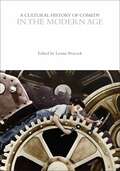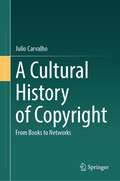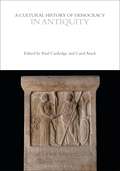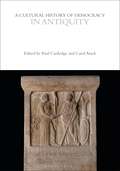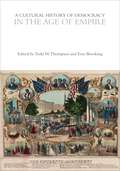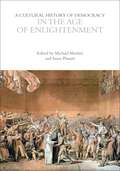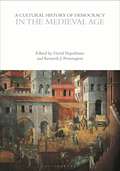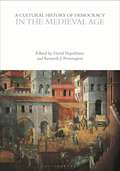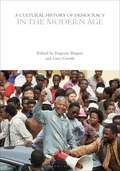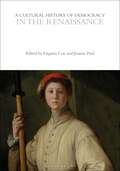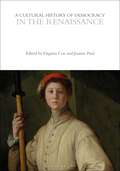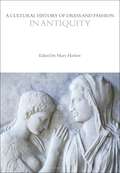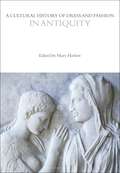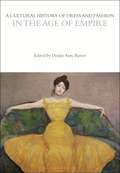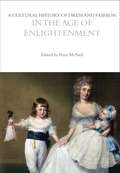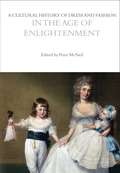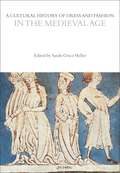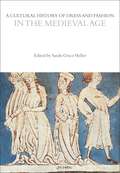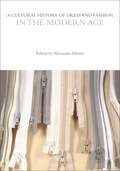- Table View
- List View
A Cultural History of Comedy in the Modern Age (The Cultural Histories Series)
by Andrew McConnell Stott Eric WeitzDrawing together contributions by scholars from a variety of fields, including theater, film and television, sociology, and visual culture, this volume explores the range and diversity of comedic performance and comic forms in the modern age. It covers a range of forms and examples from 1920 to the present day, including plays, film, television comedy, live comedy, and comedy on social media. It argues that the period covered was marked by an explosion of comic forms and a flowering of comic creativity across a range of media. From the communal watching of silent films at the start of the period, to the use of Twitter and other online platforms to share and comment on comedy, technology has brought about significant changes in its form, consumption, and social effects. As comic forms have shifted and developed, so too have attitudes to what comedy can and cannot do. This study considers its role in entertainment and in provoking consideration of a range of social and political topics. Each chapter takes a different theme as its focus: form, theory, praxis, identities, the body, politics and power, laughter, and ethics. These eight different approaches to comedy add up to an extensive, synoptic coverage of the subject.
A Cultural History of Comedy in the Modern Age (The Cultural Histories Series)
by Andrew McConnell Stott Eric WeitzDrawing together contributions by scholars from a variety of fields, including theater, film and television, sociology, and visual culture, this volume explores the range and diversity of comedic performance and comic forms in the modern age. It covers a range of forms and examples from 1920 to the present day, including plays, film, television comedy, live comedy, and comedy on social media. It argues that the period covered was marked by an explosion of comic forms and a flowering of comic creativity across a range of media. From the communal watching of silent films at the start of the period, to the use of Twitter and other online platforms to share and comment on comedy, technology has brought about significant changes in its form, consumption, and social effects. As comic forms have shifted and developed, so too have attitudes to what comedy can and cannot do. This study considers its role in entertainment and in provoking consideration of a range of social and political topics. Each chapter takes a different theme as its focus: form, theory, praxis, identities, the body, politics and power, laughter, and ethics. These eight different approaches to comedy add up to an extensive, synoptic coverage of the subject.
A Cultural History of Copyright: From Books to Networks
by Julio CarvalhoCombining philosophical and historical perspectives, this book focuses on the rise of a legal institution that has dominated the economy of knowledge ever since it burst onto the scene at the dawn of modernity in the heartlands of Europe. From the age of print to the age of networks and disruptive technologies, this book explores the place of copyright amid the various conceptual transformations it has undergone over time. Uniquely, it presents an in-depth philosophical treatment of the cultural history of copyright from its beginnings to the present. Although copyright is a central topic, the content is by no means limited to it. The main question the author seeks to answer is: how do legal institutions emerge and how do they evolve over time? Though copyright is a wonderful example for tackling this question, a selection of other institutions, such as the social practice of promising in eighteenth-century Britain, are also addressed at considerable length. What the author has managed to show in this book is that the transformations which modern law has undergone since the eighteenth century are inextricably linked to those which have shaped the modern subject to the core. Law forms part of those great schemes of intelligibility that allow us to understand ourselves better. We need to delve deep into the multiple layers of culture if we want to fully understand how the morphology and cultural archaeology of our legal institutions intertwine.
A Cultural History of Democracy in Antiquity (The Cultural Histories Series)
by Paul Cartledge and Carol AtackThis volume surveys democracy broadly as a cultural phenomenon operating in different ways across a very wide range of ancient societies throughout Antiquity. It examines the experiences of those living in democratic communities and considers how ancient practices of democracy differ from our own.The origins of democracy can be traced in a general way to the earliest civilizations, beginning with the early urban societies of the Middle East, and can be seen in cities and communities across the Mediterranean world and Asia. In classical Athens, male citizens enjoyed full participation in the political life of the city and a flourishing democratic culture, as explored in detail in this volume. In other times and places democratic features were absent from the formal structures of regimes, but could still be found in the participatory structures of local social institutions.Each chapter takes a different theme as its focus: sovereignty; liberty and the rule of law; the “common good”; economic and social democracy; religion and the principles of political obligation; citizenship and gender; ethnicity, race, and nationalism; democratic crises, revolutions, and civil resistance; international relations; and beyond the polis. These ten different approaches to democracy in Antiquity add up to an extensive, synoptic coverage of the subject.
A Cultural History of Democracy in Antiquity (The Cultural Histories Series)
This volume surveys democracy broadly as a cultural phenomenon operating in different ways across a very wide range of ancient societies throughout Antiquity. It examines the experiences of those living in democratic communities and considers how ancient practices of democracy differ from our own.The origins of democracy can be traced in a general way to the earliest civilizations, beginning with the early urban societies of the Middle East, and can be seen in cities and communities across the Mediterranean world and Asia. In classical Athens, male citizens enjoyed full participation in the political life of the city and a flourishing democratic culture, as explored in detail in this volume. In other times and places democratic features were absent from the formal structures of regimes, but could still be found in the participatory structures of local social institutions.Each chapter takes a different theme as its focus: sovereignty; liberty and the rule of law; the “common good”; economic and social democracy; religion and the principles of political obligation; citizenship and gender; ethnicity, race, and nationalism; democratic crises, revolutions, and civil resistance; international relations; and beyond the polis. These ten different approaches to democracy in Antiquity add up to an extensive, synoptic coverage of the subject.
A Cultural History of Democracy in the Age of Empire (The Cultural Histories Series)
by Tom Brooking and Todd M. ThompsonThis volume surveys democracy broadly as a cultural phenomenon operating in different ways across a very wide range of societies in the nineteenth-century world. In the long nineteenth century, democracy evolved from a contested, maligned conception of government with little concrete expression at the level of the state, to a term widely associated with good governance throughout the diverse political cultures of the Atlantic world and beyond. The geographical scope and public range of discussions about the meaning of democracy in this era were unprecedented in comparison to previous centuries. These lively debates involved fundamental questions about human nature, and encompassed subjects ranging from the scope of the people who would participate in self-government to the importance of social and economic issues. For these reasons, the nineteenth century has proven the formative century in the modern history of democracy.Each chapter takes a different theme as its focus: sovereignty; liberty and the rule of law; the “common good”; economic and social democracy; religion and the principles of political obligation; citizenship and gender; ethnicity, race, and nationalism; democratic crises, revolutions, and civil resistance; international relations; and beyond the polis. These ten different approaches to democracy in the nineteenth century add up to an extensive, synoptic coverage of the subject.
A Cultural History of Democracy in the Age of Empire (The Cultural Histories Series)
This volume surveys democracy broadly as a cultural phenomenon operating in different ways across a very wide range of societies in the nineteenth-century world. In the long nineteenth century, democracy evolved from a contested, maligned conception of government with little concrete expression at the level of the state, to a term widely associated with good governance throughout the diverse political cultures of the Atlantic world and beyond. The geographical scope and public range of discussions about the meaning of democracy in this era were unprecedented in comparison to previous centuries. These lively debates involved fundamental questions about human nature, and encompassed subjects ranging from the scope of the people who would participate in self-government to the importance of social and economic issues. For these reasons, the nineteenth century has proven the formative century in the modern history of democracy.Each chapter takes a different theme as its focus: sovereignty; liberty and the rule of law; the “common good”; economic and social democracy; religion and the principles of political obligation; citizenship and gender; ethnicity, race, and nationalism; democratic crises, revolutions, and civil resistance; international relations; and beyond the polis. These ten different approaches to democracy in the nineteenth century add up to an extensive, synoptic coverage of the subject.
A Cultural History of Democracy in the Age of Enlightenment (The Cultural Histories Series)
This volume surveys the burst of political imagination that created multiple Enlightenment cultures in an era widely understood as an age of democratic revolutions. Enlightenment as precursor to liberal democratic modernity was once secular catechism for generations of readers. Yet democracy did not elicit much enthusiasm among contemporaries, while democracy as a political system remained virtually nonexistent through much of the period. If seventeenth- and eighteenth-century ideas did underwrite the democracies of succeeding centuries, they were often inheritances from monarchical governments that had encouraged plural structures of power competition. But in revolutions across France, Britain, and North America, the republican integration of constitutional principle and popular will established rational hope for public happiness. Nevertheless, the tragic clashes of principle and will in fraught revolutionary projects were also democratic legacies. Each chapter focuses on a distinct theme: sovereignty; liberty and the rule of law; the “common good”; economic and social democracy; religion and the principles of political obligation; citizenship and gender; ethnicity, race, and nationalism; democratic crises, revolutions, and civil resistance; international relations; and the transformations of sovereignty-a synoptic survey of the cultural entanglements of “enlightenment” and “democracy.”
A Cultural History of Democracy in the Age of Enlightenment (The Cultural Histories Series)
This volume surveys the burst of political imagination that created multiple Enlightenment cultures in an era widely understood as an age of democratic revolutions. Enlightenment as precursor to liberal democratic modernity was once secular catechism for generations of readers. Yet democracy did not elicit much enthusiasm among contemporaries, while democracy as a political system remained virtually nonexistent through much of the period. If seventeenth- and eighteenth-century ideas did underwrite the democracies of succeeding centuries, they were often inheritances from monarchical governments that had encouraged plural structures of power competition. But in revolutions across France, Britain, and North America, the republican integration of constitutional principle and popular will established rational hope for public happiness. Nevertheless, the tragic clashes of principle and will in fraught revolutionary projects were also democratic legacies. Each chapter focuses on a distinct theme: sovereignty; liberty and the rule of law; the “common good”; economic and social democracy; religion and the principles of political obligation; citizenship and gender; ethnicity, race, and nationalism; democratic crises, revolutions, and civil resistance; international relations; and the transformations of sovereignty-a synoptic survey of the cultural entanglements of “enlightenment” and “democracy.”
A Cultural History of Democracy in the Medieval Age (The Cultural Histories Series)
by Eugenio BiaginiOffering a broad exploration of the cultural history of democracy in the medieval age, this volume claims that, though not generally associated with the term, the Middle Ages deserve to be included in a general history of democracy. The term was never widely employed during this period, the dominant attitude towards democracy was outright hostility, and none of the medieval polities thought of itself as a democracy. Despite this, this study highlights a wide variety of ideas, practices, procedures, and institutions that, although different from their ancient predecessor (direct democracy) or modern successor (liberal representative democracy), played a significant role in the history of democracy. This volume covers almost 1,000 years and a wide range of territories. It deals with different political spheres (ecclesiastical and secular) and socio-political settings (courtly, urban, and rural) and examines the phenomenon from the local level up to the universal realm. This volume adopts a broad cultural approach and is structured thematically. Each chapter takes a theme as its focus: sovereignty; liberty and the rule of law; the common good; economic and social democracy; religion and the principles of political obligation; citizenship and gender; ethnicity, race, and nationalism; democratic crises, revolutions, and civil resistance; international relations; and the scalability of democracy beyond the limits of a single city. These ten themes add up to an extensive, synoptic coverage of the subject.
A Cultural History of Democracy in the Medieval Age (The Cultural Histories Series)
by Eugenio BiaginiOffering a broad exploration of the cultural history of democracy in the medieval age, this volume claims that, though not generally associated with the term, the Middle Ages deserve to be included in a general history of democracy. The term was never widely employed during this period, the dominant attitude towards democracy was outright hostility, and none of the medieval polities thought of itself as a democracy. Despite this, this study highlights a wide variety of ideas, practices, procedures, and institutions that, although different from their ancient predecessor (direct democracy) or modern successor (liberal representative democracy), played a significant role in the history of democracy. This volume covers almost 1,000 years and a wide range of territories. It deals with different political spheres (ecclesiastical and secular) and socio-political settings (courtly, urban, and rural) and examines the phenomenon from the local level up to the universal realm. This volume adopts a broad cultural approach and is structured thematically. Each chapter takes a theme as its focus: sovereignty; liberty and the rule of law; the common good; economic and social democracy; religion and the principles of political obligation; citizenship and gender; ethnicity, race, and nationalism; democratic crises, revolutions, and civil resistance; international relations; and the scalability of democracy beyond the limits of a single city. These ten themes add up to an extensive, synoptic coverage of the subject.
A Cultural History of Democracy in the Modern Age (The Cultural Histories Series)
by Eugenio F. Biagini and Gary GerstleThis volume explores democracy in the 20th century, examining the triumph, crises, recovery, and resilience of democracy and its associated cultures in this period.From 1920 democracy became the hegemonic discourse in political cultures, to the extent that even its enemies claimed its legacy. The end of empires ushered in an unprecedented globalization of democratic aspirations. Barriers of gender and race were gradually removed, and greater equality gave new meaning to citizenship. Yet, already in 1922 democracy was on its back foot with the rise of fascism. Even after the latter's defeat in 1945, liberal democracy died wherever communist democracy triumphed. The situation changed again from 1989, but democratic hubris was then checked by the rise of a new enemy-populism. The paradox is that the century of democracy's triumph was also that of its near final defeat, while the peace and stability that everybody desired and many expected as the outcome of the extension of democracy were, at best, intermittent and geographically limited. Each chapter takes a different theme as its focus: sovereignty; liberty and the rule of law; the “common good”; economic and social democracy; religion and the principles of political obligation; citizenship and gender; ethnicity, race, and nationalism; democratic crises, revolutions, and civil resistance; international relations; and democratic politics beyond the polis. These ten different approaches to democracy since 1920 offer a global, synoptic, and probing exploration of the subject.
A Cultural History of Democracy in the Modern Age (The Cultural Histories Series)
This volume explores democracy in the 20th century, examining the triumph, crises, recovery, and resilience of democracy and its associated cultures in this period.From 1920 democracy became the hegemonic discourse in political cultures, to the extent that even its enemies claimed its legacy. The end of empires ushered in an unprecedented globalization of democratic aspirations. Barriers of gender and race were gradually removed, and greater equality gave new meaning to citizenship. Yet, already in 1922 democracy was on its back foot with the rise of fascism. Even after the latter's defeat in 1945, liberal democracy died wherever communist democracy triumphed. The situation changed again from 1989, but democratic hubris was then checked by the rise of a new enemy-populism. The paradox is that the century of democracy's triumph was also that of its near final defeat, while the peace and stability that everybody desired and many expected as the outcome of the extension of democracy were, at best, intermittent and geographically limited. Each chapter takes a different theme as its focus: sovereignty; liberty and the rule of law; the “common good”; economic and social democracy; religion and the principles of political obligation; citizenship and gender; ethnicity, race, and nationalism; democratic crises, revolutions, and civil resistance; international relations; and democratic politics beyond the polis. These ten different approaches to democracy since 1920 offer a global, synoptic, and probing exploration of the subject.
A Cultural History of Democracy in the Renaissance (The Cultural Histories Series)
by Virginia Cox and Joanne PaulThis volume offers a broad exploration of the cultural history of democracy in the Renaissance. The Renaissance has rarely been considered an important moment in the history of democracy. Nonetheless, as this volume shows, this period may be seen as a “democratic laboratory” in many, often unexpected, ways. The classicizing cultural movement known as humanism, which spread throughout Europe and beyond in this period, had the effect of vastly enhancing knowledge of the classical democratic and republican traditions. Greek history and philosophy, including the story of Athenian democracy, became fully known in the West for the first time in the postclassical world. Partly as a result of this, the period from 1400 to 1650 witnessed rich and historically important debates on some of the enduring political issues at the heart of democratic culture: issues of sovereignty, of liberty, of citizenship, of the common good, of the place of religion in government. At the same time, the introduction of printing, and the emergence of a flourishing, proto-journalistic news culture, laid the basis for something that recognizably anticipates the modern “public sphere.” The expansion of transnational and transcontinental exchange, in what has been called the “age of encounters,” gave a new urgency to discussions of religious and ethnic diversity. Gender, too, was a matter of intense debate in this period, as was, specifically, the question of women's relation to political agency and power. This volume explores these developments in ten chapters devoted to the notions of sovereignty, liberty, and the “common good”; the relation of state and household; religion and political obligation; gender and citizenship; ethnicity, diversity, and nationalism; democratic crises and civil resistance; international relations; and the development of news culture. It makes a pressing case for a fresh understanding of modern democracy's deep roots.
A Cultural History of Democracy in the Renaissance (The Cultural Histories Series)
This volume offers a broad exploration of the cultural history of democracy in the Renaissance. The Renaissance has rarely been considered an important moment in the history of democracy. Nonetheless, as this volume shows, this period may be seen as a “democratic laboratory” in many, often unexpected, ways. The classicizing cultural movement known as humanism, which spread throughout Europe and beyond in this period, had the effect of vastly enhancing knowledge of the classical democratic and republican traditions. Greek history and philosophy, including the story of Athenian democracy, became fully known in the West for the first time in the postclassical world. Partly as a result of this, the period from 1400 to 1650 witnessed rich and historically important debates on some of the enduring political issues at the heart of democratic culture: issues of sovereignty, of liberty, of citizenship, of the common good, of the place of religion in government. At the same time, the introduction of printing, and the emergence of a flourishing, proto-journalistic news culture, laid the basis for something that recognizably anticipates the modern “public sphere.” The expansion of transnational and transcontinental exchange, in what has been called the “age of encounters,” gave a new urgency to discussions of religious and ethnic diversity. Gender, too, was a matter of intense debate in this period, as was, specifically, the question of women's relation to political agency and power. This volume explores these developments in ten chapters devoted to the notions of sovereignty, liberty, and the “common good”; the relation of state and household; religion and political obligation; gender and citizenship; ethnicity, diversity, and nationalism; democratic crises and civil resistance; international relations; and the development of news culture. It makes a pressing case for a fresh understanding of modern democracy's deep roots.
A Cultural History of Dress and Fashion in Antiquity (The Cultural Histories Series)
by Mary HarlowWhilst seemingly simple garments such as the tunic remained staples of the classical wardrobe, sources from the period reveal a rich variety of changing styles and attitudes to clothing across the ancient world. Covering the period 500 BCE to 800 CE and drawing on sources ranging from extant garments and architectural iconography to official edicts and literature, this volume reveals Antiquity's preoccupation with dress, which was matched by an appreciation of the processes of production rarely seen in later periods. From a courtesan's sheer faux-silk garb to the sumptuous purple dyes of an emperor's finery, clothing was as much a marker of status and personal expression as it was a site of social control and anxiety. Contemporary commentators expressed alarm in equal measure at the over-dressed, the excessively ascetic or at 'barbarian' silhouettes. Richly illustrated with 100 images, A Cultural History of Dress and Fashion in Antiquity presents an overview of the period with essays on textiles, production and distribution, the body, belief, gender and sexuality, status, ethnicity, visual representations, and literary representations.
A Cultural History of Dress and Fashion in Antiquity (The Cultural Histories Series)
by Mary HarlowWhilst seemingly simple garments such as the tunic remained staples of the classical wardrobe, sources from the period reveal a rich variety of changing styles and attitudes to clothing across the ancient world. Covering the period 500 BCE to 800 CE and drawing on sources ranging from extant garments and architectural iconography to official edicts and literature, this volume reveals Antiquity's preoccupation with dress, which was matched by an appreciation of the processes of production rarely seen in later periods. From a courtesan's sheer faux-silk garb to the sumptuous purple dyes of an emperor's finery, clothing was as much a marker of status and personal expression as it was a site of social control and anxiety. Contemporary commentators expressed alarm in equal measure at the over-dressed, the excessively ascetic or at 'barbarian' silhouettes. Richly illustrated with 100 images, A Cultural History of Dress and Fashion in Antiquity presents an overview of the period with essays on textiles, production and distribution, the body, belief, gender and sexuality, status, ethnicity, visual representations, and literary representations.
A Cultural History of Dress and Fashion in the Age of Empire (The Cultural Histories Series)
by Denise Amy BaxterDuring the nineteenth and early twentieth centuries the production of dress shifted dramatically from being predominantly hand-crafted in small quantities to machine-manufactured in bulk. The increasing democratization of appearances made new fashions more widely available, but at the same time made the need to differentiate social rank seem more pressing. In this age of empire, the coding of class, gender and race was frequently negotiated through dress in complex ways, from fashionable dress which restricted or exaggerated the female body to liberating reform dress, from self-defining black dandies to the oppressions and resistances of slave dress. Richly illustrated with over 100 images and drawing on a plethora of visual, textual and object sources, A Cultural History of Dress and Fashion in the Age of Empire presents essays on textiles, production and distribution, the body, belief, gender and sexuality, status, ethnicity, and visual and literary representations to illustrate the diversity and cultural significance of dress and fashion in the period.
A Cultural History of Dress and Fashion in the Age of Empire (The Cultural Histories Series)
During the nineteenth and early twentieth centuries the production of dress shifted dramatically from being predominantly hand-crafted in small quantities to machine-manufactured in bulk. The increasing democratization of appearances made new fashions more widely available, but at the same time made the need to differentiate social rank seem more pressing. In this age of empire, the coding of class, gender and race was frequently negotiated through dress in complex ways, from fashionable dress which restricted or exaggerated the female body to liberating reform dress, from self-defining black dandies to the oppressions and resistances of slave dress. Richly illustrated with over 100 images and drawing on a plethora of visual, textual and object sources, A Cultural History of Dress and Fashion in the Age of Empire presents essays on textiles, production and distribution, the body, belief, gender and sexuality, status, ethnicity, and visual and literary representations to illustrate the diversity and cultural significance of dress and fashion in the period.
A Cultural History of Dress and Fashion in the Age of Enlightenment (The Cultural Histories Series)
by Peter McNeilEighteenth-century fashion was cosmopolitan and varied. Whilst the wildly extravagant and colorful elite fashions parodied in contemporary satire had significant influence on wider dress habits, more austere garments produced in darker fabrics also reflected the ascendancy of a puritan middle class as well as a more practical approach to dress. With the rise of print culture and reading publics, fashions were more quickly disseminated and debated than ever, and the appetite for fashion periodicals went hand in hand with a preoccupation with the emerging concept of taste. Richly illustrated with 100 images and drawing on pictorial, textual and object sources, A Cultural History of Dress and Fashion in the Age of Enlightenment presents essays on textiles, production and distribution, the body, belief, gender and sexuality, status, ethnicity, and visual and literary representations to illustrate the diversity and cultural significance of dress and fashion in the period.
A Cultural History of Dress and Fashion in the Age of Enlightenment (The Cultural Histories Series)
by Peter McNeilEighteenth-century fashion was cosmopolitan and varied. Whilst the wildly extravagant and colorful elite fashions parodied in contemporary satire had significant influence on wider dress habits, more austere garments produced in darker fabrics also reflected the ascendancy of a puritan middle class as well as a more practical approach to dress. With the rise of print culture and reading publics, fashions were more quickly disseminated and debated than ever, and the appetite for fashion periodicals went hand in hand with a preoccupation with the emerging concept of taste. Richly illustrated with 100 images and drawing on pictorial, textual and object sources, A Cultural History of Dress and Fashion in the Age of Enlightenment presents essays on textiles, production and distribution, the body, belief, gender and sexuality, status, ethnicity, and visual and literary representations to illustrate the diversity and cultural significance of dress and fashion in the period.
A Cultural History of Dress and Fashion in the Medieval Age (The Cultural Histories Series)
by Sarah-Grace HellerDuring the medieval period, people invested heavily in looking good. The finest fashions demanded careful chemistry and compounds imported from great distances and at considerable risk to merchants; the Church became a major consumer of both the richest and humblest varieties of cloth, shoes, and adornment; and vernacular poets began to embroider their stories with hundreds of verses describing a plethora of dress styles, fabrics, and shopping experiences. Drawing on a wealth of pictorial, textual and object sources, the volume examines how dress cultures developed – often to a degree of dazzling sophistication – between the years 800 to 1450. Beautifully illustrated with 100 images, A Cultural History of Dress and Fashion in the Medieval Age presents an overview of the period with essays on textiles, production and distribution, the body, belief, gender and sexuality, status, ethnicity, visual representations, and literary representations.
A Cultural History of Dress and Fashion in the Medieval Age (The Cultural Histories Series)
During the medieval period, people invested heavily in looking good. The finest fashions demanded careful chemistry and compounds imported from great distances and at considerable risk to merchants; the Church became a major consumer of both the richest and humblest varieties of cloth, shoes, and adornment; and vernacular poets began to embroider their stories with hundreds of verses describing a plethora of dress styles, fabrics, and shopping experiences. Drawing on a wealth of pictorial, textual and object sources, the volume examines how dress cultures developed – often to a degree of dazzling sophistication – between the years 800 to 1450. Beautifully illustrated with 100 images, A Cultural History of Dress and Fashion in the Medieval Age presents an overview of the period with essays on textiles, production and distribution, the body, belief, gender and sexuality, status, ethnicity, visual representations, and literary representations.
A Cultural History of Dress and Fashion in the Modern Age (The Cultural Histories Series)
by Alexandra PalmerOver the last century there has been a complete transformation of the fashion system. The unitary top-down fashion cycle has been replaced by the pulsations of multiple and simultaneous styles, while the speed of global production and circulation has become ever faster and more complex. Running in tandem, the development of artificial fibres has revolutionized the composition of clothing, and the increased focus on youth, sexuality, and the body has radically changed its design. From the 1920s flapper dress to debates over the burkini, fashion has continued to be deeply involved in society's larger issues.Drawing on a wealth of visual, textual and object sources and illustrated with 100 images, A Cultural History of Dress and Fashion in the Modern Age presents essays on textiles, production and distribution, the body, belief, gender and sexuality, status, ethnicity, and visual and literary representations to illustrate the diversity and cultural significance of dress and fashion in the period.
A Cultural History of Dress and Fashion in the Modern Age (The Cultural Histories Series)
by Alexandra PalmerOver the last century there has been a complete transformation of the fashion system. The unitary top-down fashion cycle has been replaced by the pulsations of multiple and simultaneous styles, while the speed of global production and circulation has become ever faster and more complex. Running in tandem, the development of artificial fibres has revolutionized the composition of clothing, and the increased focus on youth, sexuality, and the body has radically changed its design. From the 1920s flapper dress to debates over the burkini, fashion has continued to be deeply involved in society's larger issues.Drawing on a wealth of visual, textual and object sources and illustrated with 100 images, A Cultural History of Dress and Fashion in the Modern Age presents essays on textiles, production and distribution, the body, belief, gender and sexuality, status, ethnicity, and visual and literary representations to illustrate the diversity and cultural significance of dress and fashion in the period.
